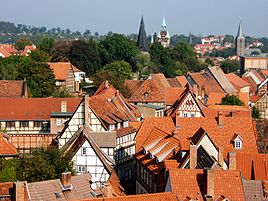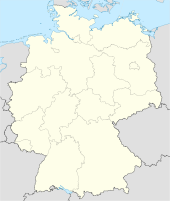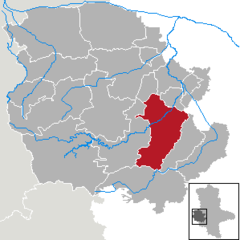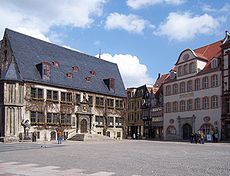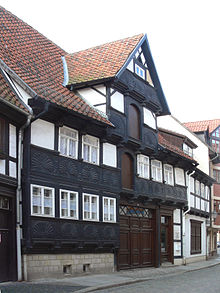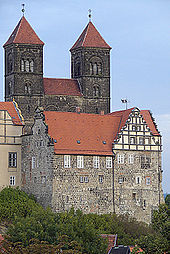- Quedlinburg
-
Quedlinburg View from the castle 
Coordinates 51°47′30″N 11°8′50″E / 51.79167°N 11.14722°ECoordinates: 51°47′30″N 11°8′50″E / 51.79167°N 11.14722°E Administration Country Germany State Saxony-Anhalt District Harz Town subdivisions 3 Stadtteile Mayor Eberhard Brecht (SPD) Basic statistics Area 141.82 km2 (54.76 sq mi) Elevation 123–182 m Expression error: Unrecognised punctuation character "�" Population 28,424 (31 December 2010)[1] - Density 200 /km2 (519 /sq mi) Other information Time zone CET/CEST (UTC+1/+2) Licence plate HZ Postal code 06484 Area code 03946 Website www.quedlinburg.de Collegiate Church, Castle, and Old Town of Quedlinburg * UNESCO World Heritage Site
The market square of Quedlinburg.Country Germany Type Cultural Criteria iv Reference 535 Region ** Europe and North America Inscription history Inscription 1994 (18th Session) * Name as inscribed on World Heritage List
** Region as classified by UNESCOQuedlinburg (German pronunciation: [ˈkveːdlɪnbʊʁk]) is a town located north of the Harz mountains, in the district of Harz in the west of Saxony-Anhalt, Germany. In 1994 the medieval court and the old town was set on the UNESCO world heritage list.
Until 2007 it was the capital of the district of Quedlinburg. Some places in town with Romanesque architecture are part of the holiday route Romanesque Road, such as St Servatius' church at the castles hill, St Wigbert's church down the valley and St Maries church on the Montsion's hill ('Muenzenberg').
Contents
History
The town of Quedlinburg is known since at least the early 9th century, when a settlement known as Gross Orden existed at the eastern bank of the river Bode. As such the city is first mentioned in 922, as part of a donation by Henry the Fowler. The records of this donation were collected at the abbey of Corvey.
After Henry's death in 936, his widow Saint Mathilda founded a religious community for women ("Frauenstift") on the castle hill, where daughters of the higher nobility were educated. The main task of this collegiate foundation, Quedlinburg Abbey (where the Annals of Quedlinburg were compiled), was to pray for the memory of King Henry and the rulers that came after him. The first abbess was Mathilde, granddaughter of Henry and Saint Mathilde.
The Quedlinburg castle complex, founded by Henry the Fowler and built up by Otto I the Great in 936, was an imperial palatinate of the Saxon emperors. The palatinate, including the male convent, was in the valley, where nowadays the Roman Catholic church of St Wiperti is situated, while the women's convent was located on the castle hill.
In 961 and 963 a Canon's monastery was established in St. Wiperti, south of the castle hill. It was abandoned in the 16th century, and at one time the church, which boasts a magnificent crypt from the 10th century, was even used as a barn and a pigsty before being restored in the 1950s.
In 973, shortly before the death of emperor Otto I the Great, a Reichstag (Imperial Convention) was held at the imperial court in which Mieszko, duke of Poland, and Boleslav, duke of Bohemia, as well as numerous other nobles from as far away as Byzantium and Bulgaria, gathered to pay homage to the emperor. In the occasion Otto the Great introduced his new daughter-in-law Theophanu, a Byzantine princess whose marriage to Otto II brought hope for recognition and continued peace between the rulers of the Eastern and Western empires.
In 994 Otto III granted the right of market, tax and coining and established the first market place to the north of the castle hill.
The town became a member of the Hanseatic League in 1426. Quedlinburg Abbey frequently disputed the independence of Quedlinburg, which sought the aid of the Bishopric of Halberstadt. In 1477 Abbess Hedwig, aided by her brothers Ernest and Albert, broke the resistance of the town and expelled the bishop's forces. Quedlinburg was forced to leave the Hanseatic League and was subsequently protected by the Electorate of Saxony. Both town and abbey converted to Lutheranism in 1539 during the Protestant Reformation.
In 1697 Elector Frederick Augustus I of Saxony sold his rights to Quedlinburg to Elector Frederick III of Brandenburg for 240,000 thalers. Quedlinburg Abbey contested Brandenburg-Prussia's claims throughout the 18th century, however. The abbey was secularized in 1802 during the German Mediatisation and Quedlinburg passed to the Kingdom of Prussia as part of the Principality of Quedlinburg. Part of the Napoleonic Kingdom of Westphalia from 1807–13, it was included within the new Prussian Province of Saxony in 1815. In all this time, great ladies ruled Quedlinburg as abbesses without "taking the veil", they were free to marry. The last of these great ladies were a Swedish princess, an early fighter for women's rights,[citation needed] Sofia Albertina.
During the Nazi regime, the memory of Henry I became a sort of cult, as Heinrich Himmler saw himself as the reincarnation of the "most German of all German" rulers. The collegiate church and castle were to be turned into a shrine for Nazi Germany. The Nazi Party tried to create a new religion. The cathedral was closed from 1938 and during the war. Liberation in 1945 brought back the Protestant bishop and the church bells, and the Nazi style eagle was taken down from the tower. Georg Ay was local party chief from 1931 until the end of the war.
Quedlinburg was administered within Bezirk Halle while part of the Communist East Germany from 1949 to 1990. It became part of the state of Saxony-Anhalt upon German reunification in 1990.
During Quedlinburg's Communist era as part of the GDR (1949–1990), restoration specialists from Poland were called in during the 1980s to carry out repairs on the old architecture. As in all German cities the Altstadt old city medieval sections, are the most popular attractions of any town. Now Quedlinburg is a center of restoration of Fachwerk houses.
During the last months of World War II, the United States Military occupied Quedlinburg. In the 1980s, upon the death of one of the US Military men, the Theft of medieval art from Quedlinburg came to light.
Main sights
In the innermost parts of the town a wide selection of half-timbered buildings from at least five different centuries are to be found (including a 14th century structure one of Germany's oldest), while around the outer fringes of the old town there are wonderful examples of Jugendstil buildings, dating from the late 19th and early 20th centuries.
Since December 1994 the old town of Quedlinburg and the castle mount with the collegiate church are listed as one of UNESCO's World Heritage Sites.[2] Quedlinburg is one of the best-preserved medieval and renaissance towns in Europe, having escaped major damage in World War II.
In 2006 the Harzer Schmalspurbahnen Selketal branch was extended into Quedlinburg from Gernrode giving access to the historic steam narrow gauge railway, Alexisbad and high Harz plateau.
The castle and the cathedral still towers above the city the way they dominated the town in early Middle Ages. The cathedral is a prime example of German Romanesque style. The Domschatz, the treasure containing ancient artefacts and books, was stolen by an American soldier and finally bought back to Quedlinburg in 1993 and is again on display here.
Geography
The town is located north of the Harz mountains approximatively 123 meters above sea level. The nearest mountains reach 181 meters above sea level. The biggest part of the town is located in the western part of the river Bodes bed. This river comes from the Harz mountains and flows into the river Saale and further into the river Elbe. The towns area is about 78.15 square kilometre.
Climate
Quedlinburg has a humid continental climate (Köppen climate classification) resulting from Prevailing Westerlies, blowing from the high pressure area in the central Atlantic towards Scandinavia. Snowfall occurs almost every winter. January and February are the coldest months of the year, with an average temperature of 0.1 °C and 0.4 °C. July and August are the hottest months, with an average temperature of 17.8 °C (63 °F) and 17.2 °C. The average annual precipitation is close to 438 millimetres with rain occurring usually from May to September. This precipitation is one of the lowest in Germany, which has an annual average close to 700 millimetres. In August 2010 Quedlinburg was the driest place in Germany with only 72,4 liter per square-meter.[3]
Climate data for Quedlinburg Month Jan Feb Mar Apr May Jun Jul Aug Sep Oct Nov Dec Year Average high °C (°F) 2
(36)4
(39)8
(46)13
(55)19
(66)21
(70)22
(72)23
(73)19
(66)13
(55)6
(43)3
(37)12.8
(55.0)Daily mean °C (°F) 0.1
(32.2)0.4
(32.7)3.7
(38.7)7.8
(46.0)12.9
(55.2)16.7
(62.1)17.8
(64.0)17.2
(63.0)13.9
(57.0)9.6
(49.3)4.7
(40.5)1.5
(34.7)8.86
(47.94)Average low °C (°F) −1
(30)−1
(30)1
(34)3
(37)8
(46)10
(50)12
(54)13
(55)9
(48)6
(43)1
(34)0
(32)5.1
(41.1)Precipitation mm (inches) 23
(0.91)22
(0.87)28
(1.1)38
(1.5)53
(2.09)57
(2.24)47
(1.85)54
(2.13)33
(1.3)27
(1.06)30
(1.18)26
(1.02)438
(17.24)% humidity 87 83 82 74 67 71 72 69 78 82 87 86 78.2 Avg. rainy days 11 9 10 10 10 11 10 10 9 9 11 12 122 Sunshine hours 47.2 66.9 107.5 136.7 182.6 172.2 186.4 183.6 139.0 104.9 63.2 42.1 1,432.3 Source no. 1: Deutscher Wetterdienst, Normalperiode 1961–1990[4] Source no. 2: Zoover[5] Demographics
Historical populations Year Pop. ±% 1786 8,382 — 1807 10,476 +25.0% 1820 11,507 +9.8% 1830 12,001 +4.3% 1840 13,431 +11.9% 1852 13,886 +3.4% 1861 14,835 +6.8% 1871 16,800 +13.2% 1880 18,437 +9.7% 1890 20,761 +12.6% 1900 23,378 +12.6% 1910 27,233 +16.5% 1919 28,190 +3.5% 1939 30,320 +7.6% 1946 35,142 +15.9% 1950 35,555 +1.2% 1955 33,125 −6.8% 1960 30,965 −6.5% 1965 30,840 −0.4% 1970 30,829 −0.0% 1975 29,711 −3.6% 1980 28,585 −3.8% 1985 29,394 +2.8% 1990 28,663 −2.5% 1995 25,844 −9.8% 2000 24,114 −6.7% 2005 22,607 −6.2% 2009* 21,203 −6.2% Source:[6] Transportation
Air
The nearest airports to Quedlinburg are Hannover 120 km north-west, and Leipzig/Halle Airport 90 km south-east. Much closer, but only served by small private planes and business jets, is Magdeburg-Cochstedt.
Train
 Narrow gauge steam train of the Selke Valley Railway connects with Veolia Harz-Berlin-Express train on the line from Magdeburg at Quedlinburg station
Narrow gauge steam train of the Selke Valley Railway connects with Veolia Harz-Berlin-Express train on the line from Magdeburg at Quedlinburg station
Regional trains run on the standard gauge Magdeburg–Thale line by Deutsche Bahn and the private company Connex connect Quedlinburg with Magdeburg, Thale and Halberstadt.
In 2006 the Selke Valley branch of the Harz Narrow Gauge Railways was extended into Quedlinburg from Gernrode, giving access to the historic steam narrow gauge railway, Alexisbad and high Harz plateau.
Bus
Quedlinburg is connected by regional buses to the surrounding villages and small towns.
Additionally there are also buses to Berlin, run by the company BerlinLinienBus.
Notable people
Jordanus of Quedlinburg was a 14th century preacher and monk wrote texts about contemporary devoutness.
In 18th century Dorothea Erxleben was the first female medical doctor in Germany.[7] Friedrich Gottlieb Klopstock was a contemporary German poet of Johann Wolfgang von Goethe.
Sister cities
Quedlinburg is twinned with:
 Aulnoye-Aymeries, France, since 1961
Aulnoye-Aymeries, France, since 1961 Herford, Germany, since 1991
Herford, Germany, since 1991 Celle, Germany, since 1991
Celle, Germany, since 1991 Hameln, Germany, since 1991
Hameln, Germany, since 1991 Hann. Münden, Germany, since 1991
Hann. Münden, Germany, since 1991
References
- ^ "Bevölkerung der Gemeinden nach Landkreisen" (in German). Statistisches Landesamt Sachsen-Anhalt. 31 December 2010. http://www.statistik.sachsen-anhalt.de/download/stat_berichte/6A102_hj_2010_02.pdf.
- ^ Unesco World heritage list
- ^ Press release of the Deutsche Wetterdienst (pdf, German)
- ^ "Deutscher Wetterdienst, Normalperiode 1961–1990" (in German). Deutscher Wetterdienst. http://www.dwd.de.
- ^ "Zoover data by DWD". December 2010. http://www.zoover.de/deutschland/sachsen-anhalt/quedlinburg/wetter.
- ^ "Annual Estimates of the Resident Population". Statistisches Landesamt Sachsen-Anhalt – Bevölkerung der Gemeinden nach Landkreisen; Stand: 31. Dez. 2009. http://www.statistik.sachsen-anhalt.de/download/stat_berichte/6A102_hj_2009_02.pdf.
- ^ Schiebinger, L. (1990): "The Anatomy of Difference: Race and Sex in Eighteenth-Century Science" p. 399, Eighteenth Century Studies 23(3) pp. 387–405
Further reading
- Honan, William H. (1997). Treasure Hunt. A New York Times Reporter Tracks the Quedlinburg Hoard. New York: Fromm International Publishing Corporation. ISBN 0-88064-174-6.
- Kogelfranz, Siegfried; Willi A. Korte (1994). Quedlinburg – Texas and Back. Black Marketeering with Looted Art.
External links
- The city's website (German)
- UNESCO page on Quedlinburg
- a lot of pictures and informations about timber frame homes in Quedlinburg
- The Quedlinberg Art Affair
- 207 recent photos from Quedlinburg

Halberstadt Oschersleben Magdeburg 
Blankenburg 
Aschersleben  Quedlinburg
Quedlinburg 

Nordhausen Sangerhausen Halle Ballenstedt | Blankenburg (Harz) | Ditfurt | Falkenstein | Groß Quenstedt | Halberstadt | Harsleben | Harzgerode | Hedersleben | Huy | Ilsenburg | Nordharz | Oberharz am Brocken | Osterwieck | Quedlinburg | Schwanebeck | Selke-Aue | Thale | Wegeleben | Wernigerode
Members of the Hanseatic League by Quarter Chief cities are highlighted; Free Imperial Cities of the Holy Roman Empire are shown in italics.Wendish Quarter Anklam · Demmin · Greifswald · Hamburg · Kolberg (Kołobrzeg) · Lüneburg · Rostock · Rügenwalde (Darłowo) · Stettin (Szczecin) · Stolp (Słupsk) · Stockholm · Stralsund · Visby · Wismar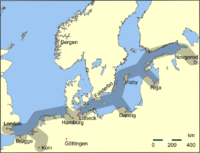
Saxon Quarter Baltic Quarter Westphalian
QuarterPrincipal Kontore Subsidiary Kontore Other cities Categories:- Towns in Saxony-Anhalt
- World Heritage Sites in Germany
- Quedlinburg
- Art and cultural repatriation
- Landmarks in Germany
- Romanesque Road
- Hanseatic League
Wikimedia Foundation. 2010.

